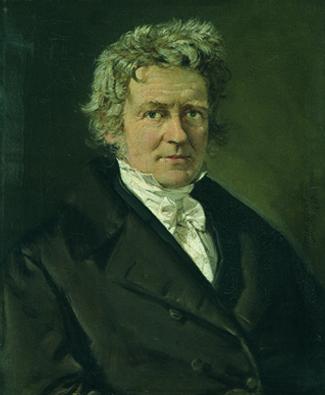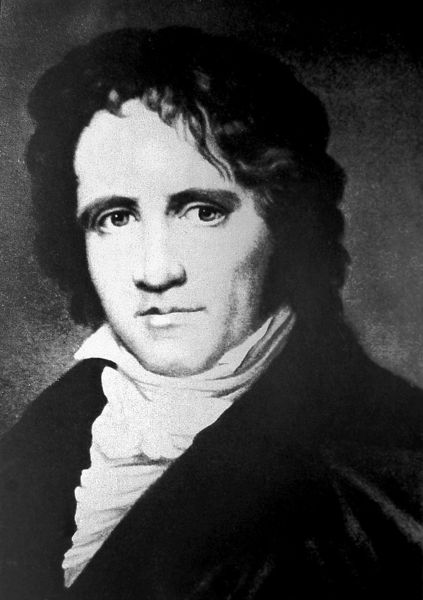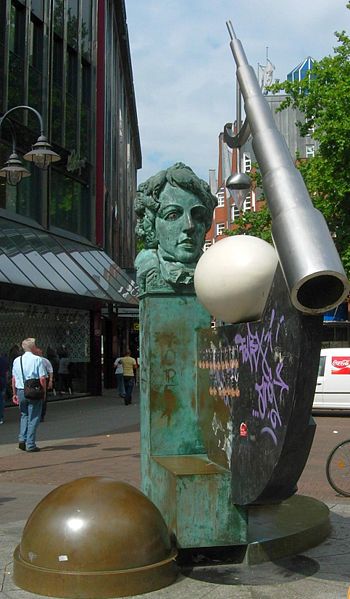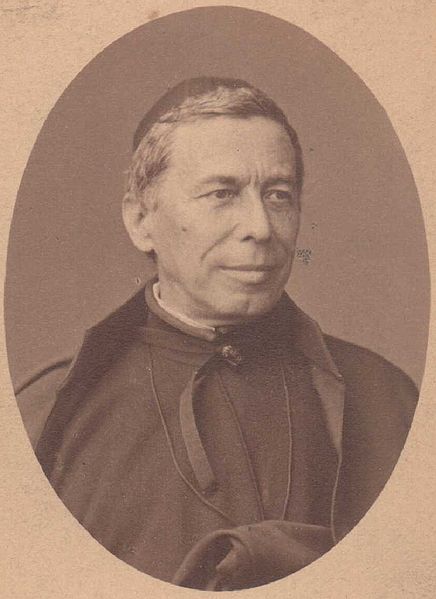<Back to Index>
- Mathematician and Astronomer Friedrich Wilhelm Bessel, 1784
- Astronomer Pietro Angelo Secchi, 1818
PAGE SPONSOR



Friedrich Wilhelm Bessel (22 July 1784 – 17 March 1846) was a German mathematician, astronomer, and systematizer of the Bessel functions (which were discovered by Daniel Bernoulli). He was a contemporary of Carl Gauss, also a mathematician and physicist. The asteroid 1552 Bessel was named in his honor.
Bessel was born in Minden in Minden - Ravensberg, the son of a civil servant. At the age of 14 Bessel was apprenticed to the import - export concern Kulenkamp. He soon became the company's accountant. The business's reliance on cargo ships led him to turn his mathematical skills to problems in navigation. This in turn led to an interest in astronomy as a way of determining longitude.
Bessel came to the attention of a major figure of German astronomy at the time, Heinrich Wilhelm Olbers, by producing a refinement on the orbital calculations for Halley's Comet. Within two years Bessel had left Kulenkamp and became an assistant at Lilienthal Observatory near Bremen. There he worked on James Bradley's stellar observations to produce precise positions for some 3,222 stars.
This work attracted considerable attention, and in 1810, at the age of 26, Bessel was appointed director of the Königsberg Observatory by King Frederick William III of Prussia. There he published tables of atmospheric refraction based on Bradley's observations, which won him the Lalande Prize from the French Academy of Sciences in 1811. Bessel was able to pin down the position of over 50,000 stars during his time at Königsberg.
With this work under his belt, Bessel was able to achieve the feat for which he is best remembered today: He is credited with being the first to use parallax in calculating the distance to a star. Astronomers had believed for some time that parallax would provide the first accurate measurement of interstellar distances — in fact, in the 1830s there was a fierce competition between astronomers to be the first to measure a stellar parallax accurately. In 1838 Bessel won the race, announcing that 61 Cygni had a parallax of 0.314 arcseconds; which, given the diameter of the Earth's orbit, indicated that the star is 10.4 ly away. If the currently accepted figure of 11.4 ly is correct, Bessel' figure had an error of 8.8%. He narrowly beat Friedrich Georg Wilhelm Struve and Thomas Henderson, who measured the parallaxes of Vega and Alpha Centauri in the same year.
As well as helping determine the parallax of 61 Cygni, Bessel's precise measurements allowed him to notice deviations in the motions of Sirius and Procyon, which he deduced must be caused by the gravitational attraction of unseen companions. His announcement of Sirius's "dark companion" in 1844 was the first correct claim of a previously unobserved companion by positional measurement, and eventually led to the discovery of Sirius B.
Despite lacking a university education, Bessel was a major figure in astronomy during his lifetime. He was elected a fellow of the Royal Society, a foreign member of the Royal Swedish Academy of Sciences in 1823, and the largest crater in the Moon's Mare Serenitatis is named Bessel after him. Bessel's work in 1840 contributed in some degree to the discovery of Neptune. In 1832, he was elected a Foreign Honorary Member of the American Academy of Arts and Sciences. Bessel won the Gold Medal of the Royal Astronomical Society in 1841.
In the second decade of the 19th century while studying the dynamics of 'many - body' gravitational systems, Bessel developed what are now known as Bessel functions. Critical for the solution of certain differential equations, these functions are used throughout both classical and quantum physics. Even in the absence of any work in astronomy, Bessel's role in developing the functions which now bear his name would have, by itself, placed him among the most significant and influential mathematicians of the 19th century.
He died in the spring of 1846 in Königsberg from cancer. This was several months short of the discovery of Neptune in the fall of that year, by his colleagues at Berlin Observatory.

Father Pietro Angelo Secchi SJ (29 June 1818 – 26 February 1878) was an Italian astronomer. He was Director of the Observatory at the Pontifical Gregorian University (then called the Roman College) for 28 years. He was a pioneer in astronomical spectroscopy, and was one of the first scientists to state authoritatively that the Sun is a star.
He was born in Reggio Emilia, where he studied at the Jesuit gymnasium. At the age of 16, he entered the Jesuit Order in Rome. He continued his studies at the Roman College, and demonstrated great scientific ability. In 1839, he was appointed tutor of mathematics and physics at the College. In 1841, he became Professor of Physics at the Jesuit College in Loreto. In 1844 he began theological studies in Rome, and was ordained a priest on 12 September 1847. In 1848, due to the Roman Revolution, the Jesuits had to leave Rome. Fr. Secchi spent the next two years in the United Kingdom at Stonyhurst College, and the United States, where he taught for a time at Georgetown University in Washington, DC. He also took his doctoral examination in theology there.
During his stay in America, he met Commander Matthew Fontaine Maury, the first Director of the United States Naval Observatory in Washington. He studied with Maury and corresponded with him for many years.
He returned to Rome in 1850. On the recommendation of his late colleague Francesco de Vico, he became head of the Observatory of the College at age 32. Under his direction, the crumbling Observatory was relocated to a new facility on top of the Church of St. Ignatius (the chapel of the College). Fr. Secchi served as Director until his death.
His position was challenged after 1870, when the remnant of the Papal States around Rome was taken over by the Kingdom of Italy. In 1873, the College was declared property of the Italian government. When the government moved to take over the Observatory as well, Fr. Secchi protested vigorously, and threatened to leave the Observatory for one of several positions offered to him by foreign observatories. He was offered important scientific positions and political dignities by the government, but refused to pledge allegiance to the Kingdom in place of the Pope. The royal government did not dare to interfere with him, and he continued as Director.
He died in 1878 at age 59.
Father Secchi made contributions to many areas of astronomy.
- He revised Struve's catalog of double stars, compiling data for over 10,000 binaries.
- He discovered three comets, including Comet Secchi.
- He produced an exact map of the lunar crater Copernicus.
- He drew some of the first color illustrations of Mars and was the first to refer to "canali", the Italian word for channels, on the planetary surface.
Fr. Secchi was especially interested in the Sun, which he observed continually throughout his career.
- He observed and made drawings of solar eruptions and sunspots, and compiled records of sunspot activity.
- In 1860 and 1870, he organized expeditions to observe solar eclipses.
- He proved that the solar corona and coronal prominences observed during a solar eclipse were part of the Sun, and not artifacts of the eclipse.
- He discovered solar spicules.
However, his main area of interest was astronomical spectroscopy. He invented the heliospectrograph, star spectrograph, and telespectroscope. He showed that certain absorption lines in the spectrum of the Sun were caused by absorption in the Earth's atmosphere.
Starting
in 1863, he began collecting the spectra of stars, accumulating some
4,000 stellar spectrograms. Through analysis of this data, he discovered
that the stars come in a limited number of distinct types and subtypes,
which could be distinguished by their different spectral patterns. From
this concept, he developed the first system of stellar classification: the five Secchi classes. While his system was superseded by the Harvard system, he still stands as discoverer of the principle of stellar classification, which is a fundamental element of astrophysics. His recognition of molecular bands of carbon radicals in the spectra of some stars made him the discoverer of carbon stars, which made one of his spectral classes.
Father Secchi was active in oceanography, meteorology, and physics, as well as astronomy.
He invented the Secchi disk, which is used to measure water transparency in oceans and lakes.
He studied the climate of Rome and invented a "Meteorograph" for the convenient recording of several categories of weather data. He also studied the aurora borealis and the effects of lightning, and investigated the cause of hail.
He organized the systematic monitoring of the Earth's magnetic field, and in 1858 established a Magnetic Observatory in Rome.
Fr. Secchi also performed related technical works for the Papal government, such as overseeing placement of sundials and repair or installation of municipal water systems.
In 1854 - 1855, he supervised an exact survey of the Via Appia in Rome. This survey was later used in the topographic mapping of Italy.
He supervised construction of lighthouses for the ports of the Papal States. In 1858, he traveled to France and Germany to procure the necessary projection lenses.
The lunar crater Secchi and the Martian crater Secchi are both named after him.
The two STEREO (Solar TErrestrial RElations Observatory) spacecraft each carry an instrument package called SECCHI (Sun Earth Connection Coronal and Heliospheric Investigation).